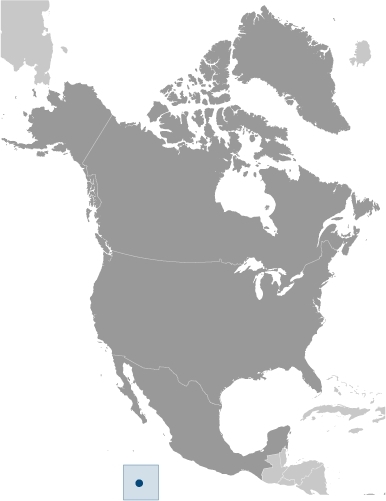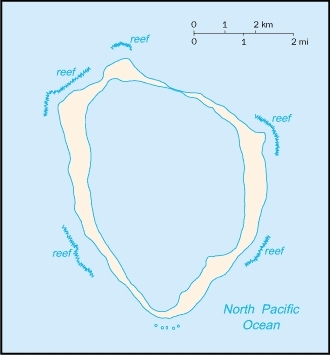Clipperton Island (Biodiversity)
Clipperton Island
| Topics: |
Countries and Regions of the World Collection  Clipperton Island (also Ile de la Passion) is an uninhabbited atoll (a reef 12 km in circumference with a completely enclosed lagoon,) in the North Pacific Ocean, 1,120 km southwest of Mexico.
Clipperton Island (also Ile de la Passion) is an uninhabbited atoll (a reef 12 km in circumference with a completely enclosed lagoon,) in the North Pacific Ocean, 1,120 km southwest of Mexico.
It is a possession of France; administered directly by the Minister of Overseas France.
This isolated island was named for John Clipperton, a pirate who made it his hideout early in the 18th century.
Annexed by France in 1855, it was seized by Mexico in 1897. Arbitration eventually awarded the island to France, which took possession in 1935.
Guano mining began on the island in the late-1800’s, and in 1906 the British Pacific Island Company along with the Mexican government built a settlement in order to exploit this natural resource.
The bird excrement is valuable for its phosphate content, and is processed into fertilizers.
By 1914, 100 people were living on the island, with a supply ship visiting every other month from Acapulco.
At the start of the Mexican civil war, the supply ship stopped coming, and by 1917, only three surviving women were rescued by an American ship.
The atoll was later occupied by the U.S. military during World War II operations.
Remnants of these visits still remain on the island, including abandoned military supplies and the ruins of a lighthouse.
Pigs were introduced at the end of the 19th century, and by 1958, there were 58 pigs on the island eating plants, crabs, and bird eggs; these were all slaughtered that year in order to protect the nesting birds, which had experienced marked declines in population.
Coconut palms were planted in 1897, and now grow in several groves.
Though significant damage was done to Clipperton's native flora and fauna during this short period of human habitation, the island is still considered one of the least disturbed systems in the Pacific. Despite many proposals, there is no current legal protection for the island.
Although 115 species of fish have been identified in the territorial waters of Clipperton Island, the only economic activity is tuna fishing.
The island is now visited primarily by the French Navy, infrequent scientific expeditions, and United States tuna fishermen who may occasionally come ashore.
Access to the island is difficult due to the heavy oceanic swell. However, an account from a 1994 visit notes that the expedition encountered many abandoned boat anchors along with other debris directly offshore. A tuna boat that was line-fishing for reef fish and several sailing yachts were reportedly offshore during the visit as well.
At one time, it was proposed that the lagoon be opened for construction of a port, though it appears that these plans were dropped.
Meteorological stations have operated on the island, and it is a potential site for a satellite observation post. Further disturbance would likely result from these activities. It has been recommended that the island be protected as a scientific research site.
Geography
Location: Middle America, atoll
Geographic Coordinates: 10 17 N, 109 13 W
Area: 6 sq km
Coastline: 11.1 km
Maritime Claims:
Natural Hazards:
Terrain: coral atoll The highest point is Rocher Clipperton (29 m).
Climate: tropical; humid, average temperature 20-32 degrees C, wet season (May to October)
Natural Resources: fish
Ecology
The Clipperton Island shrub and grasslands ecoregion covers the island.
It is the only coral island, or atoll, in the eastern Pacific. It lies about 965 kilometers (km) from Tejupan Point on Mancanilla Bay, Mexico, the nearest mainland. Clipperton is positioned at the edge of the Eastern Pacific Barrier, which is the world's largest deepwater barrier to the dispersal of marine shore organisms. This lends interest from a biogeographical perspective, as it is an area with unusual assemblages of both Indo-Pacific and Panamic flora and faunas. It is possible that Clipperton is an important stepping stone for connection between the two bioregions.
The band of island is generally 100-200 meters (m) wide, though it reaches 400 m in the west and narrows to 45 m in the northeast where waves occasionally spill over into the lagoon. The reef surrounding the island is exposed at low tide. The closed lagoon has a strong halocline (vertical salinity gradient), and the waters are almost fresh at the surface and highly eutrophic.
Flora in the lagoon is abundant, with extensive seagrass beds that cover 45% of the lagoon's surface. Topography is generally low, mostly less than two meters, with the exception of Clipperton Rock, a volcanic plug that reaches 21 meters. The rock is a dark igneous formation, the only visible remnant of the volcano upon which the coral atoll grew. The island has a tropical oceanic climate, with average temperatures of 20-32°C. The rainy season occurs in May-October, and the island is subject to tropical storms. Surrounding ocean waters are warm with a westerly current, which flows directly from the mainland, and is therefore responsible for much of the limited flora and fauna occurring naturally on the island.
Clipperton Island is largely covered with scrub vegetation, with a few stands of coconut palms. The scrub vegetation seems to have disappeared sometime between 1858 and 1917; when Snodgrass and Heller visited the island in 1898, they reported, "no land plant is native to the island…". Sachet, however, points out that according to historical accounts from the island in 1711, 1825, and likely in 1839, the island had a low grassy and/or suffrutescent (partially woody) vegetation. It is hypothesized that the vegetation may have been decimated by a tropical storm, and was then unable to regenerate due to the large population of land crabs. After the introduction of pigs by guano miners, the flora was able to re-establish itself as the pigs helped to keep the land crabs in check. During the period of settlement, the island’s flora was multiplied by the introduction of alien species; coconut palms (Cocos nucifera) were introduced in the 1890’s.
Based upon Sachet’s visit in 1958, the vegetation is a sparse cover of spiny grass and low thickets, a creeping plant (Ipomoea), and stands of coconut palm. This low-lying herbaceous vegetation appears to be pioneer in nature, and the majority is believed to be composed of recently introduced species. Sachet suspected that the sedges, Heliotropium curassavicum, and possibly Portulaca oleracea are native in origin. At the northwest side of the island, at least, the most abundant species are Cenchrus echinatus, Sida rhombifolia, and Corchorus aestuans. These plants compose a shrub cover up to 30 centimeters (cm) in height, and are intermixed with Eclipta, Phyllanthus, and Solanum, as well as a taller plant, Brassica juncea. An interesting feature was observed in that the vegetation is arranged in parallel rows of species; dense rows of taller species alternate with lower, more open vegetation. This was assumed to be a result of the phosphate mining method of digging trenches.
Biodiversity Features
A visitor to Clipperton Island would be most impressed by the thousands of seabirds and millions of land crabs living there. Breeding seabirds include:
- white terns (Gygis alba),
- masked booby (Sula dactylatra),
- sooty tern (Sterna fuscata),
- brown booby (Sula leucogaster),
- brown noddy (Anous stolidus),
- black noddy (Anous minutus), and
- greater frigate (Fregata minor).
One of the two distinct forms of masked booby (Sula dactylatra) occuring in the eastern Pacific is found on Clipperton Island, a yellow-billed form (S. d. "californica"). The orange-billed form (S. (d.) granti) nests almost exclusively on the Galapagos Islands and on Malpelo Island, two separate ecoregions. Ducks are reportedly common in the lagoon and migratory landbirds rest on Clipperton during winter trips to the Southern Hemisphere. In 1958, Sachet observed coot, martin, cuckoo, and yellow warbler. Other land fauna includes a lizard, Emoia cyanura, and the crab, Geocarcinus planatus, which is present in very large numbers. The lagoon is reported to support an impoverished invertebrate fauna.


